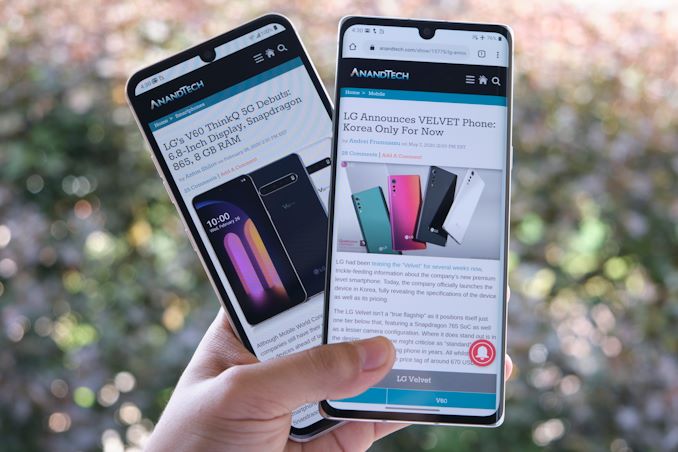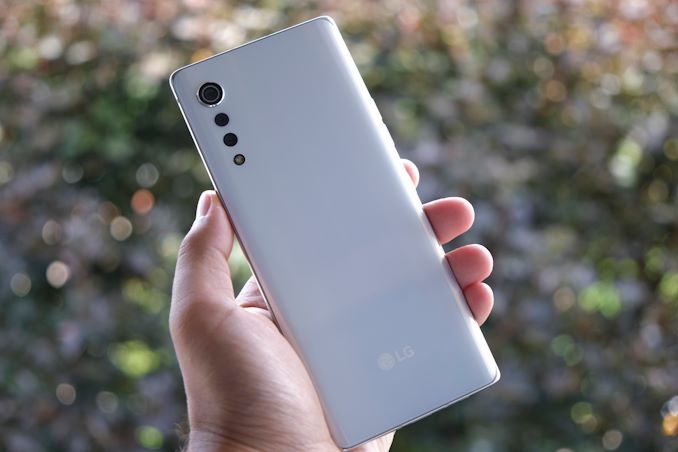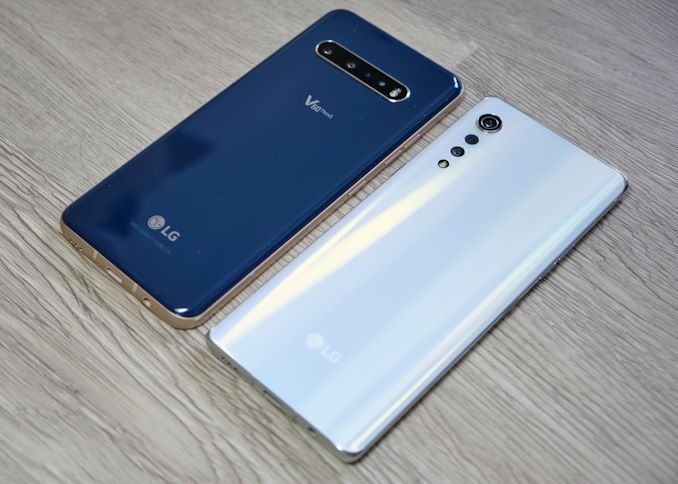The LG V60 and VELVET Review: A Classic & A Design Restart
by Andrei Frumusanu on July 15, 2020 9:00 AM EST
It’s been a few months since LG has released the LG V60, and since then the company has also finally managed to launch the new Velvet phone to western markets outside of Korea, such as Germany. The two new 2020 phones are quite contrasting devices for LG – representing what one could say the company’s classic design philosophy versus a newer, more refreshing design language. They’re also contrasting devices in terms of their specifications and positioning, with the V60 being a successor flagship devices with a high-end SoC, whilst the new Velvet is a “premium” design with the new Snapdragon 765, coming at a lower price point and some compromises in terms of specification – but not too many as to call it a mid-range phone.
Both phones are overdue a closer look, and that’s precisely what we’ll be doing today.
| LG 2020 Flagships | |||
| V60 | Velvet | ||
| SoC | Qualcomm Snapdragon 865 1x Cortex-A77 @ 2.84GHz 3x Cortex-A77 @ 2.42GHz 4x Cortex-A55 @ 1.80GHz |
Qualcomm Snapdragon 765 1x Kryo 475 (CA76) @ 2.3GHz 1x Kryo 475 (CA76) @ 2.2GHz 6x Kryo 475 (CA55) @ 1.8GHz |
|
| GPU | Adreno 650 @ 587MHz | Adreno 620 | |
| DRAM | 8 GB | 8 GB | |
| Storage | 128 GB UFS 2.1 +microSD |
128 GB UFS 2.1 +microSD |
|
| Display | 6.8" FullVision OLED 2460 x 1080 (20.5:9) |
6.8" FullVision OLED 2460 x 1080 (20.5:9) |
|
| Size | Height | 169.3 mm | 167.2 mm |
| Width | 77.6 mm | 74.1 mm | |
| Depth | 8.9 mm | 7.9 mm | |
| Weight | 218 grams | 180 grams | |
| Battery Capacity | 5000 mAh (Typical) | 4300 mAh (Typical) | |
| Wireless Charging | Qi | Qi | |
| Rear Cameras | |||
| Main | 64 MP 1/1.7" 0.8µm f/1.8 w/OIS |
48MP f/1.8 w/OIS |
|
| Wide | 13 MP 1/3.4" 1µm f/1.9 117° super-wide angle |
8MP Super-wide angle |
|
| Extra | ToF 1/4" 14µm f/1.9 117° super-wide angle |
5MP Depth |
|
| Front Camera | 10 MP 1/3.1" 1.22μm f/1.9 |
16MP | |
| I/O | USB 2.0 Type-C 3.5mm headphone jack Under-screen Fingerprint reader |
USB 2.0 Type-C 3.5mm headphone jack Under-screen Fingerprint reader |
|
| Wireless (local) | Wi-Fi 6 Bluetooth 5.1 |
Wi-Fi 6 Bluetooth 5.1 |
|
| Cellular | GSM, CDMA, HSPA, 4G/LTE, 5G | ||
| Splash, Water, Dust Resistance | IP68 | IP68 | |
| Dual-SIM | nano-SIM | nano-SIM | |
| Launch OS | Android 10 | Android 10 | |
| Launch Price | $899 | 599€ | |
In terms of specifications and the brains of the devices, as mentioned, the LG V60 is a familiar phone as it’s simply sporting the best of the best. The Snapdragon 865 features four Cortex-A77 cores, one of which clocks in at up to 2.84GHz and three others at up to 2.42GHz, paired with four low-power Cortex-A55 cores at 1.8GHz. We’ve seen excellent performance and power efficiency out of Qualcomm’s latest chipset in other 2020 flagship devices, and the LG V60 is pretty much in line with the pack in terms of performance and efficiency.
The LG Velvet on the other hand is amongst a smaller number of devices which make due with Qualcomm’s new Snapdragon 765 SoC. This “premium” model functionally has the same level of features as the flagship Snapdragon 865 SoC, but just comes at lower performance levels. In terms of IP, we find two Cortex A76 cores, one up to 2.3GHz and another up to 2.2GHz, paired with six low-power Cortex-A55 cores at 1.8GHz. The GPU in the form of the Adreno 620 is also smaller than the bigger brother’s Adreno 650 configuration.
What’s special about both these SoCs is that they’re 5G enabled. The LG V60 makes use of an external X55 modem for connectivity, while the Velvet integrates its modem capabilities inside of the Snapdragon 765.
Both phones feature 8GB of RAM (LPDDR5 for the V60 and LPDDR4X for the Velvet), and feature 128GB of storage, expandable via microSD slots.
In terms of designs, both phones are very different to each other. The one thing they share in common is the display specifications; both phones feature 6.8” 2460 x 1080 OLED displays. The resolution doesn’t surprise too much for the Velvet as it’s a lower priced phone, but it is quite weird to see LG go backwards on the V60, offering a downgrade from the 1440p resolutions of previous, smaller, V-series phones. There are battery life considerations here which we’ll discuss in more detail later, but it does stretch out quite a bit for displays of these sizes.
Both displays still make use of “dewdrop” notch designs and the cut-outs here are virtually identical between the two phones. The Velvet tries to smooth out the bezel corner near the cut-out via blacked out pixels, but other than that I wouldn’t be surprised if these were actually the same display panels.
Of course, the immediately visible difference between the two phones is their bezel designs. The V60 has a very classic look to it; a flat screen with some quite sizeable side bezels and a chamfered metal frame. The Velvet on the other hand is a lot more contemporary, employing a curved front screen design on its sides, with only a thin glossy metal frame.
You could argue that the V60 looks a lot more industrial, but for me the ergonomics of the Velvet are immeasurably better – it’s not only a physically narrower phone, but it just feels much better in hands thanks to its curvatures as well as thinner form-factor.
Despite the fact that the screen diagonals on both phones are identical, and maybe even have the same panels, the Velvet is a much handier phone. There’s also a big weight difference between the two units, as the V60 comes in at a hefty 218grams versus the Velvet’s 180g. Admittedly, the V60 uses a bigger 5000mAh battery whilst the Velvet is 14% smaller at 4300mAh (which is still respectable).
On the camera side of things, besides the SoC, it’s also where we see bigger differences between the two phones capabilities. The LG V60 has a new generation and larger 1/1.7” main camera sensor coming in with 64MP resolution, with a quad-Bayer colour filter layout binning down to 16MP in regular photos. LG uses this module’s high native resolution to achieve lossless 2x zooming – a necessity as the phone lacks a dedicated telephoto module.
The Velvet uses a similar method, albeit with a 48MP primary camera sensor that’s physically smaller in size than that of the V60’s.
In terms of ultra-wide-angle modules, the V60 features a 13MP sensor while the Velvet makes due with a mere 8MP unit. Besides price considerations, I think the Velvet might be limited by the thickness of the phone here and the deployable sensor sizes, as the phone lacks any protrusions with the UWA module sitting flush with the back glass panel (The main camera does have a small bump).
There’s also an extra ToF sensor on the V60, and unspecified 5MP depth sensor on the Velvet – both don’t actually serve as capturing modules but augment the capture abilities of the phones in modes such as portrait mode.
At the bottom of the phones, we see a similar setup of 3.5mm headphone jack, USB-C port and a three-holed bottom speaker setup (The top earpieces also serve as stereo speakers for playback). The fact that these phones still include the 3.5mm headphone jacks in 2020 makes them actually stand out to the rest of the competition who had opted to drop the useful connector in favour of profit making selling wireless audio accessories. Good on LG for sticking with their ethos.
Overall, the phones in terms of design are quite contrasting, and if you wouldn’t be familiar with them nor see their brandings, it would be hard to believe that they’re actually from the same company, released only a few months apart from each other. LG has had considerable trouble with the industrial design over the last few generations and the V60 is pretty much a continuation of that “outdated” look. The new Velvet is a fresh breath of air and I feel it actually belongs in 2020, its ergonomics are substantially better and the build quality is I feel higher than that of the V60, a bit ironic given that the two devices are positioned the other way around in terms of pricing and product categories.
















81 Comments
View All Comments
philehidiot - Wednesday, July 15, 2020 - link
Myself, it's a matter of price. For £400 more than my current SIM only package (over 24 months) I can get an S10. That's a VERY hard deal to beat. I'm currently paying £2.50 a month more than if I got on a decent 24 month contract as I've been awaiting the 5G rollout to upgrade, so I'm on a monthly contract with unlimited data. So any phone has to be available at £400 or less before even consideration as the S10 is the benchmark.flyingpants265 - Sunday, July 19, 2020 - link
Not a fan of S10's curved screen edges. Still annoying.What I needed was OP7, Samsung, or LG G4/G8, or Realme X.. with blackshark style front speakers, and no other missing features.
flyingpants265 - Monday, July 20, 2020 - link
Well... True, honestly.I'm no fan of LG, their phones are defective. And I want a phone with front speakers.
But this looks like a OP8 with headphone jack. Or S10 with no stupid curved screen.
The second Samsung, LG or OnePlus make a flagship phone with front stereo speakers, I'll be all over it.
peevee - Friday, July 24, 2020 - link
Agree on the useless pixels. Either the people are near-sighted and don't use glasses when looking at the screens, or just go by "bigger is better" attitude of self-delusion (claiming the see the difference without a double blind test).PeachNCream - Wednesday, July 15, 2020 - link
That's a lot of money to pay for a phone with a battery that isn't easily replaced. Kind of a pity since it doesn't really help make phones better in some meaningful way by stopping the user from yanking out and installing a fresh battery after it starts to get tired less than a year later.TheinsanegamerN - Wednesday, July 15, 2020 - link
Agreed, although with a capacity and runtime like that "tired in less then a year" doesnt apply. It isnt 2005 anymore.after 4 years my moto z play still has great battery life and is only just now starting to falter. Even so I agree on the price, no way I'd pay $900 for a phone.
PeachNCream - Wednesday, July 15, 2020 - link
It's probably more of a symptom of the phones that I end up using, but I do find myself on an annual-ish replacement cycle for batteries regardless of the design and that means keeping a small set of specialized tools plus rolling the dice with replacement batteries. That is present day experience though rather than one from fifteen years ago when, in fact, my cell phone battery retained its endurance for quite a bit longer due mainly to the fact that it was necessary to charge the battery once a week or so rather than daily.TheinsanegamerN - Wednesday, July 15, 2020 - link
My work gives us iPhones. While 3-4 hours runtime is the norm for them, I never had one lose appreciable battery life after less then 3 years outside of the 6s’ faulty one.My personal phones have been a moto z play and before that a note 4 with a 10,000 mah zero lemon battery. The moto is showing signs of wear after nearly 4 years, the note never showed signs of wear. Before that was a dumb phone that went many years on the original battery.
TheinsanegamerN - Wednesday, July 15, 2020 - link
I should note all my personal phones went at least 3 days on a charge when new, with the dumb phone pasting 2 weeks and the note lasting 7-8 days. The moto z play goes 3-4, but I was forced to upgrade, Id’ve stuck with the note 4 if I could.PeachNCream - Friday, July 17, 2020 - link
If I leave my phone alone, it will generally sit idle for close to four days without requiring a recharge. That is a rare thing though since I tend to put my phone to use doing just about everything I used to do on my computer. Mine tends to be busy most of the day with web activity, e-mail, lengthy writing (always working on the next novel), watching videos, streaming radio or running local music, playing a few games - mainly emulators of 8- and 16-bit consoles but sometimes a few native Android games as well so I rarely end the day without charging. Since lockdown and staying at home became a thing, I've just let my phone connected to a charger almost constantly and that's been nice.Brings me back to the point though. I usually see well over a 30% drop in battery life over the course of a year and that's annoying enough to warrant an annual replacement which is never fun thanks to spudgers, tiny hex screws and so on. It isn't the most tedious thing I get to do, but it would be a LOT better to simply make the battery removable.